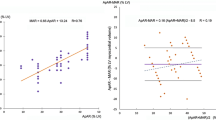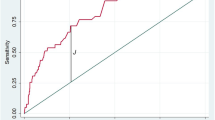Abstract
The aim of this study was to directly compare three currently used quantitative methods of analysis of technetium-99m sestamibi images in patients with selective balloon-induced transmural ischaemia. The area at risk (AR) was assessed in 19 patients undergoing singlevessel percutaneous transluminal coronary angioplasty by injecting the99mTc-sestamibi at the time of coronary artery occlusion during balloon inflation. After imaging, the patients were classified according to localization of the perfusion defect as having anteroseptal (group I, 11 patients) or posterolateral defects (group II, eight patients). The planimetric technique based on polar maps, proposed by Verani et al. (J Am Coll Cardiol, 1988) (method A), the method described by Tamaki et al. (Circulation, 1982) (method B) and the technique validated by O'Connor et al. (Eur J Nucl Med, 1990) (method C) were tested. Three threshold values of 45%, 50% and 60% of the maximum left ventricular count were used to define the limits of the perfusion defect. The mean values of the AR calculated by the three techniques with the original cut-off level (method A=16.5%±12.9; method B=10.4%±7.6%; method C=29.6%±15.7%) were statistically different (one-way analysis of variance:P<0.001; pairedt test: method A vs B,P=0.003; method B vs C and method A vs C,P<0.0001). There was no significant difference between the mean values of the AR estimated by the three methods using the same cut-off levels. The use of 60% of the maximum left ventricular count provided the best correlation between the techniques (method A vs B,r=0.95; method B vs C,r=0.92; method A vs C,r=0.95). Nevertheless, a difference >10% between the values of AR assessed by the three methods was found in four subjects. There was no significant difference between the three methods in the evaluation of AR in the subjects of group I and group II. Reproducibility was good for all methods. It is concluded that the three methods of analysis of the AR by99mTc-sestamibi SPET imaging showed comparable performance and good reproducibility using the same cut-off level. The location of perfusion defect does not affect the comparability of the three techniques. We suggest the use of a cut-off level of 60% for all three methods in the assessment of the AR by99mTc-sestamibi SPET imaging.
Similar content being viewed by others
References
Ritchie JL, Davis KB, Williams DL, Caldwell J, Kennedy JW. Global and regional left ventricular function and tomographic radionuclide perfusion: the Western Washington Intravenous Streptokinase in Myocardial Infarction Trial.Circulation 1984; 70: 867–875.
Ritchie JL, Cerqueira M, Maynard C, David K, Kennedy JW. Ventricular function and infarct size: the WesternWashington Intravenous Streptokinase in Myocardial Infarction Trial.J Am Coll Cardiol 1988; 11: 689–697.
De Coster PM, Melvin JA, Detry J-MR, Brasseur LA, Beckers C, Col J. Coronary artery reperfusion in acute myocardial infarction: assessment by pre- and post-intervention thallium-201 myocardial perfusion scintigraphy.Am J Cardiol 1985; 55: 889–895.
Feiring AJ, Johnson MR, Kioschos JM, Kirchner PT, Marcus ML, White CV. The importance of the determination of the myocardial area at risk in the evaluation of the outcome of acute myocardial infarction in patients.Circulation 1987; 75: 980–987.
Beller GA. Role of myocardial perfusion imaging in evalulating thrombolytic therapy for acute myocardial infarction.J Am Coll Cardiol 1987; 9: 661–668.
Gibbons RJ, Verani MS, Behrenbeck T, Pellika PA, O'Connor MK, Mahmarian JJ, Chesebro JH, Wackers FJ. Feasibility of tomographic99mTc-hexakis-2-methoxy-2-methylpropyl-isonitrile imaging from the assessment of myocardial area at risk and the effect of treatment in acute myocardial infarction.Circulation 1989; 80: 1277–1286.
Santoro GM, Bisi G, Sciagra' R, Leoncini M, Fazzini PF, Meldolesi U. Single photon emission computed tomography with99mTc sestaMIBI in acute myocardial infarction before and after thrombolytic treatment: assessment of salvaged myocardium and prediction of late functional recovery.J Am Coll Cardiol 1990; 15: 301–314.
Li QS, Frank TL, Franceschi D, Wagner HN, Becker LC. Technetium-99m methoxyisobutyl isonitrile (RP30) for quantification of myocardial ischemia and reperfusion in dogs.J Nucl Med 1988; 29: 1539–1548.
Verani MS, Jeroudi MO, Mahamarian JJ, Boyce TM, Borges-Nieto S, Patel B, Bolli R. Quantification of myocardial infarction during coronary occlusion and myocardial salvage after reperfusion using cardiac imaging with technetium-99m hexakis 2-methoxyisobutyl isonitrile.J Am Cell Cariol 1988; 12: 1573–1581.
Kayden DS, Mattera JA, Zaret BL, Wackers FJT. Demonstration of reperfusion after thrombolysis with technetium-99m isonitrile myocardial imaging.J Nucl Med 1988; 29: 1865–1867.
Gregoire J, Dupras G, Arsenault A, et al. Serial Tc-99m methoxy isobutyl isonitrile (MIBI) myocardial SPECT studies to assess reperfusion in patients with acute myocardial infarction [abstract].J Nucl Med 1989; 30 Suppl: 800.
Faraggi M, Assayag P, Brochet E, et al. Assessment of myocardial perfusion in acute myocardial infarction (AMI) and thrombolysis with methoxy-isobutyl-isonitrile (MIBI) tomography [abstract].Circulation 1988; 78 Suppl II: II-387.
Wackers FJT. Thrombolytic therapy for myocardial infarction: assessment of efficacy by myocardial perfusion imaging with technetium-99m sestamibi.Am J Cardiol 1990; 66: 36E–41E.
Braat SM, De Swart H, Janssen JH, Brugada P, Rigo P, Wellens HJJ. Use of technetium-99m sestamibi to determine the size of the myocardial area perfused by a coronary artery.Am J Cardiol 1990; 66: 85E–90E.
Sinusas AJ, Trautman KA, Bergin JD, Watson DD, Riuz M, Smith WH, Beller GA. Quantification of “area at risk” during coronary occlusion and degree of myocardial salvage after reperfusion using cardiac imaging with technetium-99m-hexakis-2-methoxy-isobutyl isonitrile.Circulation 1990; 1424–1437.
Tamaki S, Nakajima H, Murakami T, Yui Y, Kambara H, Kadota K, Yoshisa A, Kawai C, Tamaki N, Mukai T, Ishii Y, Torizuka K. Estimation of infarct size by myocardial emission computed tomography with thallium 201 and its relation to creatine kinase-MB release after myocardial infarction in man.Circulation 1982; 66: 994–1001.
Holman BL, Moore SC, Shulkin PM, Kirsch CM, English RJ, Hill TC. Quantitation of perfused myocardial mass using Tl-201 and emission computed tomography.Invest Radiol 1983; 18: 322–326.
Weiss RJ, Buda AJ, Pasyk S, O'Neill WW, Keyes JW, Pitt B. Noninvasive quantification of jeopardized myocardial mass in dogs using 2-dimensional echocardiography and thallium-201 tomography.Am J Cardiol 1983; 52: 1340–1344.
Garcia EV, Van Train K, Maddahi J et al. Quantification of rotational thallium-201 myocardial tomography.J Nucl Med 1985; 26: 17–26.
Pringent F, Maddahi J, Garcia EV, Satoh V, Van Train K, Berman DS. Quantification of myocardial infarct size by thallium-201 single-photon emission computed tomography: experimental validation in the dog.Circulation 1986; 74: 852–861.
Narahara KA, Thompson CJ, Maublant JC, Brizendine M, Mena I. Estimation of left ventricular mass in normal and infarcted canine hearts using Tl201 SPECT.J Nucl Med 1987; 28: 1315–1321.
Narahara KA, Thompson CJ, Maublant JC, Brizendine M, Mena I. Thallium 201 SPECT estimates of left ventricular mass in patients with and without ischemic heart disease.Am Heart J 1987; 114: 85–90.
Narahara KA, Villanueva-Meyer J, Craig JT, Brizendine M, Mena I. Comparison of thallium-201 and technetium 99m hexakis-2-methoxyisobutyl isonitrile single photon computed tomography for estimating the extent of myocardial ischemia and infarctionin coronary artery disease.Am J Cardiol 1990; 66: 1438–1444.
O'Connor MK, Hammel T, Gibbons RJ. In vitro validation of a simple tomographic technique for estimation of percentage myocardium at risk using methoxyisobutyl isonitrile technetium 99m (sestamibi).Eur J Med 1990; 17: 69–76.
De Coster PM, Wijns W, Cauwe F, Robert A, Beckers C, Melin J. Area-at-risk determination by technetium-99m-methoxyisobutyl isonitrile in experimental reperfused myocardial infarction.Circulation 1990; 82: 2152–2162.
Sinusas AJ, Smith WH, Watson DD. Quantitative SPECT isonitrile imaging accurately defines the “area at risk” during coronary occlusion [abstract].J Am Coll Cardiol 1990; 15: 227A.
Mortelmans L, Nuyts J, Vanhaecke J, Verbruggen A, De Roo M, De Geest H, Svetens P, Van de Werf F. Experimental validation of a new quantitative method for the analysis of infarct size by cardiac perfusion tomography (SPECT). Int J Card Imaging 1993; 3: 201–212.
Huber KC, Bresnahan JF, Bresnahan DR, Pellika PA, Behrenbeck T, Gibbons RJ. Measurement of myocardium at risk by Tc-99m sestaMIBI: correlation with coronary angiography.J Am Coll Cardiol 1992; 19: 67–73.
Haronian HL, Remetz MS, Sinusas AJ, Baron JM, Miller HI, Cleman MW, Zaret BL, Wackers FJ. Myocardial risk area defined by technetium-99m sestamibi imaging during percutaneous transluminal coronary angioplasty: comparison with coronary angiography.J Am Coll Cardiol 1993; 22: 1033–1043.
Okada RD, Glover D, Gaffney T, Williams S. Myocardial kinetics of technetium 99m-hexakis-2-methoxy-2-methylpropylisonitrile.Circulation 1988; 77: 491–498.
Wackers FJ, Berman DS, Maddahi J, Watson DD, Beller GA, Strauss HW, Boucher CA, Picard M, Holman BL, Fridrich R, Inglese E, Delaloye B, Bischof-Delaloye A, Camin L, McKusic K, Technetium-99m hexakis-2-methoxyisobutyl isonitrile: human biodistribution, dosimetry, safety and preliminary comparison to thallium-201 for myocardial perfusion imaging.J Nucl Med 1989; 30: 301–311.
Dilsizian V, Rocco TP, Strauss HW, Boucher CA. Technetium-99m isonitrile myocardial uptake at rest. I. Relation to severity of coronary artery stenosis.J Am Coll Cardiol 1989; 14: 1673–1677.
Author information
Authors and Affiliations
Rights and permissions
About this article
Cite this article
Ceriani, L., Verna, E., Giovanella, L. et al. Assessment of myocardial area at risk by technetium-99m sestamibi during coronary artery occlusion: comparison between three tomographic methods of quantification. Eur J Nucl Med 23, 31–39 (1996). https://doi.org/10.1007/BF01736987
Received:
Revised:
Issue Date:
DOI: https://doi.org/10.1007/BF01736987




